third Journal Part 1
Introduction
Height is a
sensitive issue in our society. Studies show that Americans are very conscious
of height. Some parents hope their children will become tall in order to be more
successful in school, sports careers and non - athletic careers. But hope is not
enough to help them grow. Most children grow about 2 inches a year between the
ages of 3 and early adolescence, when sex hormones contribute to an even faster
growth rate.
Most short children do not have a serious growth problem. Many grow at a
normal rate and reach an adult height that is about the same as their parent's.
A child's rate of growth is an important clue to the presence or absence of a
growth problem. A child who is growing at a much slower than normal rate may
have some medical problems regardless of his or her height. There are some
diseases that can cause poor growth. My program is not a panacea for every
single problem that causes poor growth. That is why you should discuss your
concerns with a doctor. But if your doctor says that you are destined to be
short and there is nothing to be done about it, don't believe him and read
further.
Our bodies are made to move, run, jump and play. If you have an active
life and have not had any prior injuries, you don't need a physical exam before
you begin his program. But if you are new to sponsor exercise, or have a problem
or past injury; it's a good idea to visit your physician.
My method has proven in be a real means of increasing growth. This method
works even for those who have not increased growth over the course of the past
few years. In my study and experiments with people of different ages who were
willing to try my method I found that even at age 25 - 28 people could increase
their height by 1 - 3 inches! Even at age 30 and up there is a possibility to
grow!
The average person, no matter what height he or she is, has a potential
to be taller by 2 - 4 inches. Why then are most people shorter than they could
get? Simply, because they don't know how to make most of their potential. That
is why I developed a program to make the most of growth potential for those who
are not satisfied with their current height. If you think growing taller will
give you some advantages in your everyday life, and you really need these
advantages, this program will give you good results. You have to really believe
in what you are doing, believe in these results, believe in what you are reading
here, and do everything I will show you!
What
is a Growth
Hormone?
Hormones are chemicals produced by special cells in glands and other
organs of the body; most hormones are produced by cells in the endocrine glands.
These hormones which are produced in very small amounts, are released into the
bloodstream and travel to the "target organ" or tissue where they
exert their effect. Several hormones are involved in regulating growth. Some act
directly on target organs, while others act by triggering the production of
other hormones, which activate specific organ functions necessary for growth.
Growth hormone is a protein produced particularly by the pituitary gland.
Proteins are made of building blocks known as amino acids. Located in the center
of our brain, The pituitary gland is often called the master gland because it
controls the release of many of the body's hormones.
There are two unnatural ways to increase growth hormone level:
Using growth hormone - releasing products like
glycine, glutamine, agrinine, ornithine, niacin, and 16 other amino acids you
can get with or without prescription. These substances and drugs are usually
used by bodybuilders. They are also useful for elderly people to increase their
growth hormone level. Some of them are good for boosting immunity, protecting
the liver, fighting cancer, helping rebuild body tissue after surgery or trauma,
and there are many other applications. Because amino acids help produce growth
hormone, some of them, with proper exercises, may be seen as increasing your
growth. I would not recommend doing this self - treatment without medical
supervision, especially for children. Any of these drugs has to be taken in
proper dosage. Some of them need to be combined with other drugs or nutrients.
Improper usage may cause you serous problems. And there are many side effects
from using these products: diarrhea, low toxicity, headache, drowsiness, muscle
spasms, dizziness high blood pressure, nervousness, depression, hair loss,
gaining weight, and many more. So, be careful.
Manmade growth hormone are administered by a series
of injections (which could cost anywhere from $12,000 to $18,000 a year), and is
prescribed after careful evaluation of a person's growth pattern and growth
potential. These injections may help you grow, but inducing growth too quickly
may inhibit later growth. Growth hormone may produce various other side effects,
such as: high cholesterol, diabetes, liver abnormalities, increased tissue
stiffness, carpal tunnel syndrome, musculoskeletal disease, neuropathy, allergic
reactions, pancreatitis, hyperglycemia, visual deterioration, headaches,
vomiting, increased liver enzyme levels, increased sweating,
edema, pain
in general and back pain specifically. Make your choice. Furthermore, if you
receive these injections, your body will adapt to this drug, and will refuse to
produce natural growth hormone after you stop receiving injections. If you think
these procedures are not for you, read further.
There are natural factors, which increase growth hormone release, as well
as factors that block it. For instance, exercise, stress, emotional excitement,
and dieting increase growth hormone release, while obesity and fatty acids act
as inhibitors It is growth hormone that grows the cells, bones, muscles, and
organs of our bodies.
Warming-up
Always warm yourself up before starting the main exercises to safely
prepare your body for the workload. Warm muscles stretch better and allow
greater range or motion for the joints. Oxygen easily releases from the blood
when the muscles are warmed gradually. This prevents you from getting out of
breath early. Warming up also improves coordination, burns fat more easily, and
reduces abnormal heart responses brought about by sudden exercise
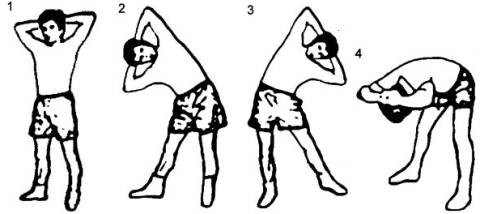
You need about 15-20 minutes to warm up: for the first 5 - 7 minutes do
some relaxed running at a moderate tempo (keep in mind - faster is not better!).
Then you will need 10-15 minutes to prepare your joints and muscles; do small
jumps on one place; bend your spine with your arms locked on the back of your
head in every possible way: to the front (as low as possible), to the sides, to
the back (fig. 1,2,3,4);
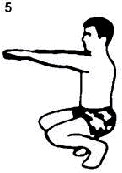
Do sit-ups (fig. 5);
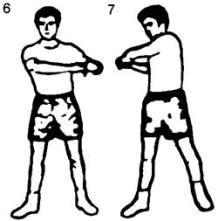
Curl your upper body
left and right while keeping your legs stable (fig. 6,7);

Move your both arms
both horizontally to the back then crossing them in the front, pushing as far as
possible. Rotate your both arms vertically, try to do it fast (fig, 8);
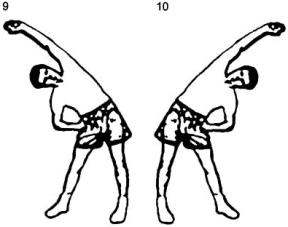
Bend your body to the
right side with left hand up to the left side with right hand up (fig. 9,10).
There are endless different exercises to warm-up your body and your
muscles, and there are exercises for every muscle. Think of every muscle in your
body and make it work, but do not try anything too hard for you. Remember your
muscles have to be warm and relaxed, not big and solid. You need to gain height,
not muscles.
Cooling-down

Cooling-down is just as important as warming-up. This is a process of
returning heart rate and breathing back to normal. This is very, very important.
At first, hold your hands together on top of your head and try to reach as high
as possible by stretching all your body (fig. 11). Try to imagine that somebody
is trying to pull you up holding your hands. Do it for one minute while you are
walking slowly. After that, move your hands together in a very slow circular
motion without touching each other. Every time your hands rise up, stretch your
legs and spine as much as possible. Don't forget - do not stop walking. 2 - 3
minutes later you just continue your slow walk relaxing and imagining the
process of your body's growth (This is one of the most important techniques
which will be explained later). Slow walking will prevent blood from pooling in
the legs, which could cause dizziness and blackouts.
Always include a warm-up and cool-down in your program. This is as
important as
basic exercise and skipping these steps may cause health problems. When you do
something really important, you need to be prepared to have good results.
Otherwise, you may spoil everything. Dont experiment with your health, just
follow my advice.
Exercising in
hot and humid or cold and wet weather conditions
Exercising in hot and humid or cold and wet weather conditions is
challenging and potentially hazardous. By being prepared, outdoor exercise can
be enjoyable and safe during any season.
Tips
for exercising in heat and humidity:
Drink plenty of fluids.
Dehydration caused by excessive sweating can lead to heat exhaustion and heat
stroke. Drink fluids before, during, and after exercise even if you dont feel
thirsty.
Dress for the heat. Wear
loose-fitting, light-colored, and lightweight clothes. Cotton is best when
sweat-soaked because it has a cooling effect.
Use common sense. As a rule, the higher the air temperature, the lower the
humidity must be to avoid risk of heat injury. For example, when air temperature exceeds 80
degrees Fahrenheit,
you are at risk
if the humidity exceeds 50 percent. During very hot and humid spells, exercise
in the cool indoors or go swimming.
Take time to adjust. The body takes time to
acclimatize to hot weather. It takes 7 to 14 days to fully acclimatize,
therefore gradually increase your exercise time.
Tips
for exercising when it's cold and wet:
Dress in multiple layers or
clothing. The
outer layer should protect
you from wind,
rain, or snow. Cold temperatures, dampness, and wind increase the risk of
hypothermia. Sweat cools the body quickly during cold weather, while wind
evaporates it faster. Wear fabrics that insulate and keep moisture away. Fabrics
made of wool and polypropylene are good, while cotton retains moisture.
Protect special body parts like your head, face,
hands, and feet. Mittens are better than gloves. Cover the head with a wool cap.
Shield the face with a scarf or high collar. Wear socks that retain heat and
keep moisture away.
Drink plenty of fluids. Do not drink alcohol before or
during a workout. It makes the body lose heat faster.
Warm-up indoors before exercising outside. Warming
your muscles will help prevent injury.
I do not recommend exercising outside if the weather
conditions are too severe.
Exercising in
hot and humid or cold and wet weather conditions
Exercising in hot and humid or cold and wet weather conditions is
challenging and potentially hazardous. By being prepared, outdoor exercise can
be enjoyable and safe during any season.
Tips
for exercising in heat and humidity:
Drink plenty of fluids.
Dehydration caused by excessive sweating can lead to heat exhaustion and heat
stroke. Drink fluids before, during, and after exercise even if you dont feel
thirsty.
Dress for the heat. Wear
loose-fitting, light-colored, and lightweight clothes. Cotton is best when
sweat-soaked because it has a cooling effect.
Use common sense. As a rule, the higher the air temperature, the lower the
humidity must be to avoid risk of heat injury. For example, when air temperature exceeds 80
degrees Fahrenheit,
you are at risk
if the humidity exceeds 50 percent. During very hot and humid spells, exercise
in the cool indoors or go swimming.
Take time to adjust. The body takes time to
acclimatize to hot weather. It takes 7 to 14 days to fully acclimatize,
therefore gradually increase your exercise time.
Tips
for exercising when it's cold and wet:
Dress in multiple layers or
clothing. The
outer layer should protect
you from wind,
rain, or snow. Cold temperatures, dampness, and wind increase the risk of
hypothermia. Sweat cools the body quickly during cold weather, while wind
evaporates it faster. Wear fabrics that insulate and keep moisture away. Fabrics
made of wool and polypropylene are good, while cotton retains moisture.
Protect special body parts like your head, face,
hands, and feet. Mittens are better than gloves. Cover the head with a wool cap.
Shield the face with a scarf or high collar. Wear socks that retain heat and
keep moisture away.
Drink plenty of fluids. Do not drink alcohol before or
during a workout. It makes the body lose heat faster.
Warm-up indoors before exercising outside. Warming
your muscles will help prevent injury.
I do not recommend exercising outside if the weather
conditions are too severe.
Morning
exercise program
The exercises which
are the base of my method, are not only great for achieving all of your growth
potential, but are also good for losing weight, keeping your body in good shape,
making your heart work more efficiently, and improving your health in many other
ways
You need to do these
exercises 4 - 5 days a week and for at least one hour each day. It is
crucial to not stop doing the exercises suddenly, because this program should be
a continuous process in order to get positive results. In other words; the only
way my method will work is if you do not stop working on your body with until
you are satisfied with the results.
The best place for
morning exercise is outdoors, in a park near you, but a gym or
fitness club will do in severe weather conditions (see section on exercising in
extreme weather conditions).
1.
Hold your hands upon a horizontal bar over your head. The bar should be
high enough to keep your feet off the ground. Completely relax your body, every
part of it (relaxing technique is very important and will be explained in the
other lesson). Hands are the only part of your body that you should be kept as
strong and muscular as possible because you will need to do this particular
exercise very often (later I'll explain how to make your hands stronger). Keep
this position of hanging on horizontal bar for about 20 - 30 seconds or less if
your hands are not strong enough (for beginners). Take a one minute break and
repeat.
2.
Try to reach some high overhanging object (like the branch of a tree)
with your fingertips by jumping in the same spot and pushing up with both of
your feet at the same time. Then try bending your legs at the knees, bending
down your body, and then stretching your body and legs. Do these jumps with all
your power, jumping as high as possible. Make 10 jumps. Do not rush. Have 5 - 8
seconds intervals between them. Rest afterward by walking slowly for 2 - 3
minutes.
3.
Now you should jump in the same spot while trying to reach the same
object and using one leg at a time. 10 times from the left leg, 30 seconds relax
time, 10 times from the right leg, 30 second relax time; 10 times hopping from
one leg to the other, switching each time (30 jumps altogether). Do slow motion
exercises for 4-5 minutes to reduce your heartbeat.
4.
Stand straight while placing your legs in a wide but comfortable and fine
position. Lock your hands together at the back of your head. Bend your body down toward your left
leg then slowly pull back up to the standing position, then bend toward the
center between your legs and back to the straight position, then bend toward
your right leg and back to the straight position, switching at every bend. Do
not bend your legs. Try to keep them straight. This might be hard at the
beginning, and it may even hurt in the muscles at the back of your legs. But
this is the way it should be. Dont bend your neck too much; try to keep it
straight (in one line with the body).
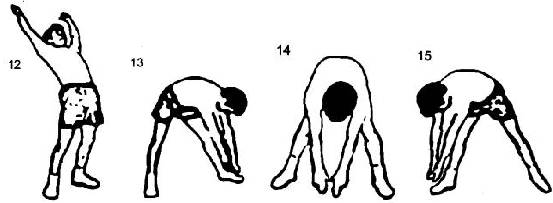
After each series of beads (left, center, and right) make one to the
back, while keeping your balance (fig. 12). Do 3 series of these light body
bends. Then do 5 series of pushing down as hard as possible. Try not to tense up
your body; let it be relaxed. Take 1 minute of slow walking, then do 5 more
series of the same bends (left, center, right), but this time let your hands
touch the floor with every bend (fig.
13,14,15).
After each series of beads (left, center, and right) make one to the
back, while keeping your balance (fig. 12). Do 3 series of these light body
bends. Then do 5 series of pushing down as hard as possible. Try not to tense up
your body; let it be relaxed. Take 1 minute of slow walking, then do 5 more
series of the same bends (left, center, right), but this time let your hands
touch the floor with every bend (fig.
13,14,15)
Now your heart should be beating fast. The technique below is very
practical to reduce your heartbeat and get a lot of extra energy for your body.
Walk slowly for a while. Hold both your arms horizontally in one line
with your palms up so you look like a cross (fig. 16). Imagine a lot or pure
energy around your body. Breath the air into your lungs and slowly move your
arms up and then down in front of you letting the air out (fig 17,18). While
doing this,

imagine grabbing the
outside energy and inserting it into your body. Do this a few times, until your
heartbeat has lessened and you feel rested.
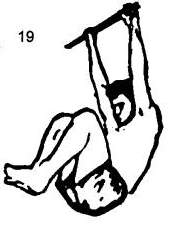
5. Hold upon the horizontal bar, relaxing for the first few
seconds then lift your legs up,
bending them at your knees, as high as possible. Keep this position for 20 - 30
seconds, then slowly lower your legs, and release the bar. Rest for 2 minutes,
and then repeat this exercise one more time.
5.
Hold upon the horizontal bar, relaxing for the
first few
seconds then lift
Take a brake for 4 - 5 minutes.
6.
Do the reaching jumps with a running start. Move back about 12 - 15 feet
(4 - 5 meters) from the object you want to reach. Run slowly toward this object
making the last two steps faster, then jump while pushing up with both of your
feet and stretching your body out to touch the object with your both hands. Do
these leaps 5 times, then, after a short break, repeat them 10
times using one
leg to jump, switching from left to right and back each time.
Explained above are the basic steps you will need to do every day, 4 - 5
times a week (as I had mentioned before). I will now give you some more
information about these exercises: if you are going to do these exercises with
someone, you can ask your partner to hold your feet down while you are hanging
on the horizontal bar, but he/she should not hold you down too strongly. Another
trick: while you are hanging on the bar, your partner, standing on a chair,
should put his hands on top of your hands in order to help you not to slip off
from the bar and to hang on for much longer. This technique is very useful when
a person doesnt have strong enough hands to hold him/herself on a bar for too
long (mostly women and children fit in this category).
As I said before, the best place to do these morning exercises is
outdoors, perhaps in a park. Clean and fresh air is the perfect environment for
gaining maximum results from this workout. Your blood will be rich in oxygen,
which will give a lot at energy for your body. It will not only help you to grow
faster, but it will also provide fresh air, which improves the health of every
part of your body and your mind.